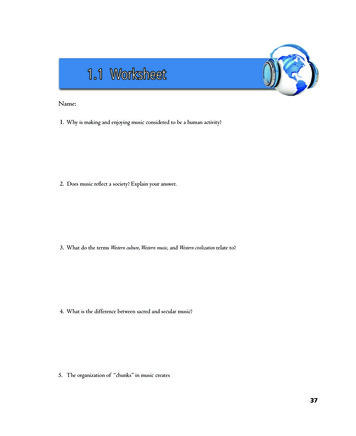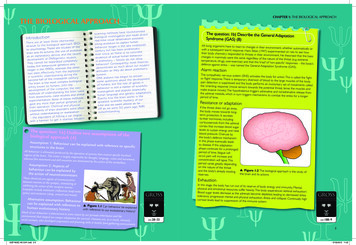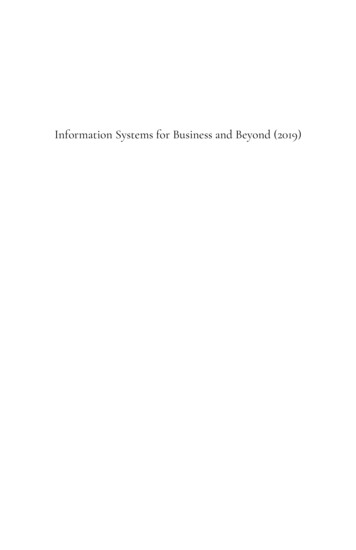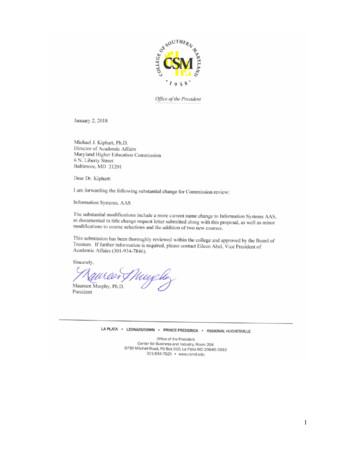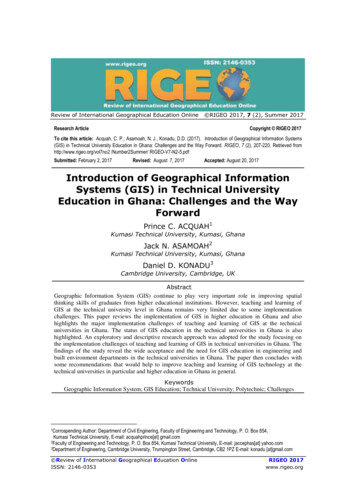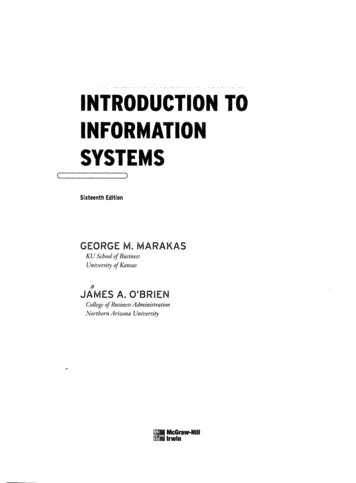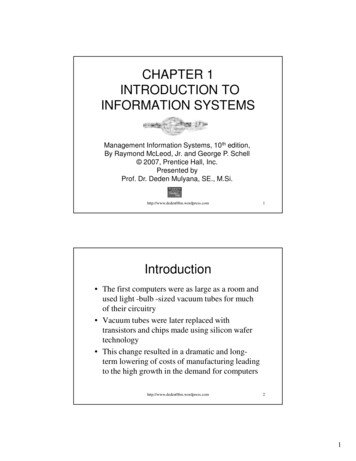
Transcription
CHAPTER 1INTRODUCTION TOINFORMATION SYSTEMSManagement Information Systems, 10th edition,By Raymond McLeod, Jr. and George P. Schell 2007, Prentice Hall, Inc.Presented byProf. Dr. Deden Mulyana, SE., n The first computers were as large as a room andused light -bulb -sized vacuum tubes for muchof their circuitry Vacuum tubes were later replaced withtransistors and chips made using silicon wafertechnology This change resulted in a dramatic and longterm lowering of costs of manufacturing leadingto the high growth in the demand for computershttp://www.deden08m.wordpress.com21
HISTORY OF INFORMATION SYSTEMS The earliest “mainframe” computers could onlyprocess a single task by a single user– 1946: ENIAC (Electronic Numerical Integrator andCalculator) was developed– 1951: first computer installed by the U.S. Census Bureau– 1954: first computer used by G.E. Over the last half century, hardware has seen manyfold increases in speed and capacity and dramaticsize reductions Applications have also evolved from relativelysimple accounting programs to systems designed tosolve a wide variety of problems3http://www.deden08m.wordpress.com[Insert Figure 1.1 here]4http://www.deden08m.wordpress.com2
Multitasking IBM revolutionized the computer industryin the mid-1960s by introducing the IBMSystem/360 line of computers These computers were the first to performmultiple processing tasks ler Computers The first small-scale systems, calledminicomputers, were smaller and lesspowerful but could handle processing forsmall organizations more cheaply Even smaller microcomputers designed forindividual use were later developed, first byApple and Tandy Corp. In 1982, IBM introduced the first personalcomputer, or PC, in 1982, which has sincebecome the standard for individualcomputing http://www.deden08m.wordpress.com63
http://www.deden08m.wordpress.com7INTRODUCTION TOCOMPUTER ARCHITECTURE Most computers have similar architecturesthat combine software and hardware Software includes the operating systemwhich controls the computer hardware andapplication software, such as wordprocessing, spreadsheets, etc. Hardware includes, processors, memoryand peripheral deviceshttp://www.deden08m.wordpress.com84
http://www.deden08m.wordpress.com9Computer Hardware The processor manages the input andoutput devices, data storage devices, andoperations on the data The central processing unit (CPU)controls all the other components Two types of memory are:– Random access memory (RAM) acts as thetemporary workspace for the CPU– Permanent data storage devices such as CDROM, floppy and hard disk driveshttp://www.deden08m.wordpress.com105
http://www.deden08m.wordpress.com11INTRODUCTION TOCOMMUNICATIONS ARCHITECTURE Modem: a hardware device that sends thecomputer’s digital signals by modulating ananalog carrier wave Data rates for various communications systems:––––Telephone lines: 56 kbpsCable modem: up to 2 MbpsWiFi: 11 MbpsLocal Area Networks: 10 to 100 Mbps Wireless has recently taken off because it’s cheapand easy to installhttp://www.deden08m.wordpress.com126
http://www.deden08m.wordpress.com13THE EVOLUTION INCOMPUTER APPLICATIONS An information system is a conceptual systemthat enables managers to control and monitor afirm’s physical systems used to transform inputresources into output resourceshttp://www.deden08m.wordpress.com147
Transaction Processing Systems A transaction processing systems isshown in Figure 1.8 It gathers data from the firm’s physicalsystem and environment and enters it intoits database The software also transforms the data intoinformation for the firm’s managers andother individuals in the firm’s tp://www.deden08m.wordpress.com8
Management Information Systems Management information systems (MIS)transform the data in frontline systems, such astransaction processing systems into informationuseful to managers Typical MIS modules are report-writing software,and models that can simulate firm operations Information from the MIS is then used byorganizational problem solvers as an aid in decisionmaking, as illustrated in Figure 1.9 Firms can also interact with suppliers or others toform inter organizational information systems(IOS), in which the MIS supplies information to theother members of the IOS as well as the firm's .deden08m.wordpress.com189
Virtual Office Systems Office automation - the use of electronics tofacilitate communication, began with wordprocessing Subsequent applications include electronic mail,voice mail, electronic calendaring, and audio andvideo conferencing These personal productivity systems nowaccount for a large portion of a firm's use of thecomputer as a communications vehicle With improvements in networking, the concept ofa virtual office has developed, in which officeactivities can be performed without the need for anemployee to be in a specific n Support Systems (DSS) A DSS is a system used to assist managers inmaking decisions to help solve a specific problem Figure 1.10 shows the 3 sources for theinformation to be delivered to users: a relationaldatabase, a knowledge base, and amultidimensional database Two additional types of DSS-related software are:– group decision support systems: used in aiding agroup of managers work out decisions, and– artificial intelligence: in which a program is createdfor a computer to logically analyze a problem on itsownhttp://www.deden08m.wordpress.com2010
21http://www.deden08m.wordpress.comEnterprise Resource PlanningSystems (ERP) Over time, firms began to use many differentkinds of information systems throughout the firm During the 1990s firms began to see the value inintegrating all of these systems so that they couldfunction as a coordinated unit ERP systems are computer-based systems aimedat meeting this need that enable the managementof all of a firm’s resources on an organizationwide basishttp://www.deden08m.wordpress.com2211
MANAGERS AS INFORMATIONSYSTEM USERS Managers exist at various managerial levelsand within various business areas of the firmWhat level an IS is developed for influenceshow it operates (see Figure 1.11)The 3 primary management levels are (seeFigure 1.12):1. Strategic planning level2. Management control level3. Operational control .deden08m.wordpress.com2412
http://www.deden08m.wordpress.com25What Managers Do Managerial Functions (Managers do thefollowing):–––––Plan what they are to doOrganize to meet the planStaff their organization with resourcesDirect them to execute the planControl the resources, keeping them on course (seeFigure 1.13) Managerial Roles:– Mintzberg’s framework is made of 10 roles thatmanagers play, grouped into interpersonal,informational, and decisional activities (see Table 1.1)http://www.deden08m.wordpress.com2613
den08m.wordpress.com14
THE ROLE OF INFORMATION INMANAGEMENT PROBLEM SOLVING While a problem can be harmful or potentiallyharmful to a firm in a negative way, it can also bebeneficial or potentially beneficial in a positive way The outcome of the problem-solving activity is asolution A decision is a particular selected course of action Simon described problem-solving as being made upof four phases:––––Intelligence activityDesign activityChoice activityReview www.deden08m.wordpress.com3015
Management Skills Communications Problem solving}How can aninformationspecialist m Solving InformationComes in Many FormsInternal SourcesExternal SourcesProblem Solvinghttp://www.deden08m.wordpress.comBusiness MealsToursVoice MailTelephoneUnscheduled MeetingsOral MediaScheduled MeetingsPeriodicalsElectronic mailLetters & MemosNoncomputer reportsComputer ReportsWritten Media1-323216
Management Knowledge Computer literacy Information literacy What’s the The CBIS ModelComputer-basedInformation System(CBIS)AccountingInformation tion SystemDecision SupportSystemsProblemSolutionThe w.deden08m.wordpress.com17
Information ServicesInformation specialists havefull-time responsibility fordeveloping and maintainingcomputer-based itional Communication den08m.wordpress.com1-363618
Justifying the CBIS Justify in the same manner as any otherlarge investment Economic– Cost reduction– Reduced inventory investment– Increased productivity (CAD/CAM) Noneconomic– Perceived ing the CBIShttp://www.deden08m.wordpress.com1-383819
Reengineering the CBIS Business Process Reengineering (BPR)– Reworking systems– Good system features retained– Becoming development methodology es Played by the Managerand by the Information SpecialistPhaseManagerInformation SpecialistPlanningDefine ontrolImplement systemUseControlMake ystem StudyDesign system1-404020
THE FUTURE OF INFORMATIONTECHNOLOGY The future of information technology willbe driven by the following two trends:– Ongoing cost reductions and increased powerof information technologies– Convergence between computers andcommunications To take advantage of these newpossibilities, managers must learn toincorporate information systems intodecision makinghttp://www.deden08m.wordpress.com41END OF CHAPTER 1http://www.deden08m.wordpress.com4221
Information from the MIS is then used by organizational problem solvers as an aid in decision-making, as illustrated in Figure 1.9 Firms can also interact with suppliers or others to form inter organizational information systems (IOS), in which the MIS supplies information to the other members of the IOS as well as the firm's users http .


